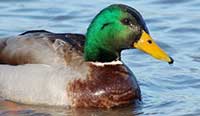 Could this be the year for duck hunters?Will this fall finally deliver waterfowl hunters the banner season theyve been expecting the past couple of years?
Could this be the year for duck hunters?Will this fall finally deliver waterfowl hunters the banner season theyve been expecting the past couple of years?
All the components are in place. Once again, nesting conditions have been superb in the North Country. Both ducks and geese populations are up.
But as Hoosier waterfowlers know all too well, it depends on the kind of weather Mother Nature hands us when the season opens Oct 24. She hasnt been very forgiving the past few seasons.
Indianas proposed season and bag limits set up similar to last year. Although the proposals require U.S. Fish and Wildlife approval, that likely wont be a problem.
Michigan hasnt announced its dates, but waterfowl insiders say you can pretty much expect the same framework as last year.
If approved, Indianas northern zone duck season will run from Oct. 24 through Dec. 13 and again Dec. 19-27. The northern goose season runs Oct. 24-Nov. 22 and Dec. 12-Jan. 24. Well also have a late Canada goose season in some northern counties, Feb. 1-15, with a bag of three.
The proposed bag limit for ducks is quite similar to last year, although the number of canvasbacks you can take has increased to two. But we dont see many cans in Indiana.
The daily bag limit for ducks in all zones is six, including no more than four mallards (of which no more than two can be hens), three scaup, three wood ducks, two pintails, two redheads, two canvasbacks, one black duck, and one mottled duck. The daily bag limit for coots is 15. The daily bag limit for mergansers, separate from ducks, is five, of which no more than two can be hooded mergansers. The possession limit is three times the daily bag limit.
The goose limit is similar, too, although the Feds have relaxed the number of white fronted geese you can take. The goose bag limit is five but only three can be Canada Geese, including the giant Canadas that live here year round. If youre lucky enough to take five white fronts, have at it.
Indiana waterfowl biologist Adam Phelps said the goose production this spring looks better across the Mississippi Flyway than it has the past couple of years.
In terms of local birds, we did quite well, he added. The number of goslings weve seen in the state this year is a lot higher than recent years.
Just like last year, mallard production is at a record level in the prairie states. Even Michigans breeding population was up this spring.
This years mallard count is about 43 percent above the long term average.
But heres the thing. Most of Indiana sits on the eastern edge of the flyway, which means youll typically find better hunting in western Hoosier counties and over into Illinois.
But if we get a break with the weather, there should be some good shooting this fall.
The last couple of years we had mild temperatures and then a solid freeze in a weekend, said Phelps. When the northern ducks are pushed down this way and see frozen water everywhere, they fly right by us. We know the ducks are there and we had good production; were just at the mercy of cold fronts.
Cold fronts in northern U.S. are good for pushing ducks into our ponds, lakes and marshes. If we can get a mild fall and winter with open water here, hunting could be spectacular.
And if you dont want to wait until October, remember there is an early goose season Sept. 1-15 for local birds and a teal season that runs Sept. 5-20. Teal numbers, especially the blue winged variety, are way up this year.
If we have hot weather theyll be hard to find, said Phelps. But if a cold front comes through early, there should be a ton of teal out there for hunters.